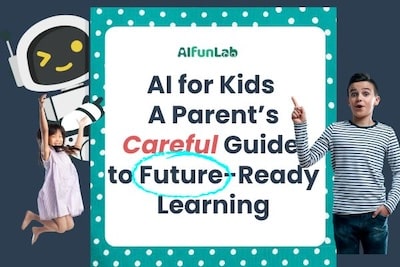What You'll Need
- Midjourney (for image generation)
- Runway or Pika Labs (for turning images into short AI videos)
- Optional: ChatGPT (for helping kids describe characters or stories)
Set Expectations
- Uploading a reference image gives better results, but may retain clothing from the photo — even if the prompt says otherwise.
- Sometimes the first result is the best — especially when colors and shapes from the original photo influence the outcome.
Alternatives
- Free Option: Use Craiyon or Artbreeder instead of Midjourney — fun, not as good quality.
- No-image option: Let kids describe themselves and generate everything using text-to-video tools like Kapwing AI, though results are less controlled.
Dive In
💡 Foundational AI Concept: This project helps kids explore generative AI, prompt engineering, and identity visualization
Option 1 (Easier): From Text to Video
Best for younger kids who love to describe themselves or cartoon figure!
Step 1: Ask your child to describe themselves or their favorite cartoon figure in their “dream look”
Example: “I have sparkly wings, purple boots, and fly on a unicorn in the clouds.”

Step 2: Optional: Use ChatGPT to refine this into a short video description prompt
Ask: “Can you turn this into a text-to-video prompt for a fairy-tale scene?”
Step 3: Paste this into your text-to-video tool (Runway, Pika, Kapwing AI)
Watch their eyes light up as their imagination comes alive.
Option 2 (More Control): Use Midjourney + Reference Image
Step 1: Take or select a clear photo of your child
Preferably front-facing, well-lit, and with simple clothing.
Step 2: Write a Midjourney prompt like:
“A cartoon version of a girl in a beautiful dress riding a unicorn, Disney-style, soft lighting, pastel colors”
🧠 Parent Pro Tip: AI can often retains clothing colors from the reference image. Try multiple versions if needed.

Step 3: Use “image + prompt” feature in Midjourney
🎛️ Pro Settings (Optional): Midjourney v7 lets you adjust how wild or realistic the results are:

--stylize(style strength)--weird(creative unpredictability)--chaos(more variety in outputs)
You’ll automatically get 4 options, but changing these settings gives you even more flexibility. Try--stylize 50for softer results.
Step 4: Choose the best image and upload it to an image-to-video tool
dd slight animation to create a magical short scene.Explain that AI doesn’t “think” — it just copies patterns. That’s why it still shows the same dress from their photo, even when told not to. This opens up a conversation about how bias and data shape AI.
🎁 More AI STEM PLAY
- Turn the AI image into a custom birthday invite
- Ask kids to draw what they see, adding their own twist
- Let them describe a new ending to the scene: What happens next?
After grad school at the London School of Economics, I worked in finance in Hong Kong, where I saw how school, access, and networks open doors into industries like private equity. Startups later took me to China and the Bay Area — where access still matters, but the timing coincided with a bigger shift. Crypto, social media, and AI began rewriting the rules. Dropouts now outpace Ivy grads, and kids build leverage before résumés. At AI Fun Lab, we help parents and educators make sense of this shift — and raise kids who can think fast and adapt.






.svg)
















